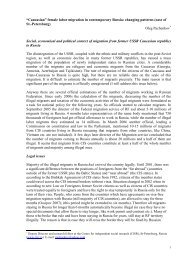THORIUM AS AN ENERGY SOURCE - Opportunities for Norway ...
THORIUM AS AN ENERGY SOURCE - Opportunities for Norway ...
THORIUM AS AN ENERGY SOURCE - Opportunities for Norway ...
You also want an ePaper? Increase the reach of your titles
YUMPU automatically turns print PDFs into web optimized ePapers that Google loves.
5.3.2.4 Gas Turbine-Modular Helium Reactor (GT-MHR)<br />
Nuclear Reactors <strong>for</strong> Thorium<br />
The Gas Turbine-Modular Helium Reactor (GT-MHR) was developed in the United States by<br />
General Atomics using a prismatic fuel. The use of helium as a coolant at high temperature and<br />
the relatively small power output per module (600 MWth) permit direct coupling of the reactor to a<br />
gas turbine (a Brayton cycle). This feature results in power generation at 48 % thermal efficiency<br />
(50 % higher than in a conventional nuclear reactor in use today). The GT-MHR core can<br />
accommodate a wide range of fuels, including highly enriched uranium/thorium, U-233/Th, and<br />
Pu/Th. The use of highly enriched uranium/thorium fuel was demonstrated in General Atomics’<br />
Fort St. Vrain reactor in Colorado.<br />
5.3.3 Molten Salt Reactor Experiment (MSRE)<br />
This advanced breeder concept circulates the fuel in molten salt, without any external coolant in<br />
the core. The primary circuit runs through a heat exchanger which transfers the heat of the<br />
fission reaction to a secondary salt circuit <strong>for</strong> steam generation. It was studied in depth in the<br />
1960s and is now being revived because of the availability of advanced technology <strong>for</strong> the<br />
materials and the components.<br />
During the 1960s the USA developed the Molten Salt Breeder Reactor (MSBR) as the primary<br />
back-up option <strong>for</strong> the conventional fast breeder reactor and a small prototype was operated. This<br />
prototype, the Molten Salt Reactor Experiment (MSRE, 8 MWth) was operated at ORNL between<br />
1965 and 1969. Three fuel types were tested: uranium enriched to 30wt% with U-235, pure U-233<br />
and Pu-239. The fuel salt consisted of 66 % LiF, 29 % BeF 2, 5 % ZrF 4 and 0.2%UF 4.In the USA, a<br />
project to produce a molten salt breeder was initiated in 1971. The electricity output was planned<br />
to be 1000 MW. The salt was composed of 71 % LiF, 16 % BeF2, 12 % ThF4 and 0.3 % UF4. The<br />
reactor was graphite moderated and had two core zones: One fissile zone where most of the power<br />
was produced, and one fertile zone where the conversion from Th-232 to U-233 would take place.<br />
The breeding ratio of this reactor was estimated at 1.06, which means that it would produce 6 %<br />
more fissile material than it consumed. The salt reprocessing was quasi-continuous with a<br />
processing time of only ten days, which seems somewhat unrealistic. More recent calculations<br />
have concluded that the proposed reactor concept had slightly positive reactivity feedback<br />
coefficients, which is undesirable <strong>for</strong> safety reasons. The project was terminated in 1976.<br />
5.3.4 Conclusion<br />
All projects using thorium in their fuel cycles had been terminated by the 1980s (except in India).<br />
The reason <strong>for</strong> this seems to be threefold: (1) the thorium fuel cycle could not compete<br />
economically with the more well-known uranium cycle, (2) a lack of political support in many<br />
countries <strong>for</strong> the development of nuclear technology in the aftermath of the Chernobyl accident<br />
and (3) an increased concern worldwide regarding the proliferation risk associated with the<br />
reprocessing of spent fuel.<br />
47

















